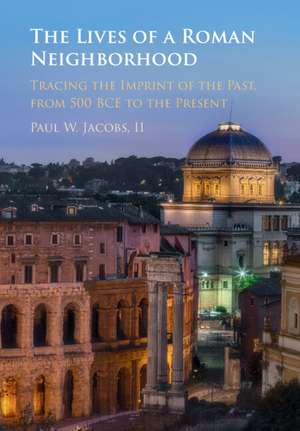The Lives of a Roman Neighborhood: Tracing the Imprint of the Past, from 500 BCE to the Present
Autor Paul W. Jacobs, IIen Limba Engleză Hardback – 30 noi 2022
Preț: 531.87 lei
Preț vechi: 578.12 lei
-8% Nou
Puncte Express: 798
Preț estimativ în valută:
101.83€ • 104.46$ • 85.74£
101.83€ • 104.46$ • 85.74£
Carte disponibilă
Livrare economică 05-19 februarie
Livrare express 22-28 ianuarie pentru 40.49 lei
Preluare comenzi: 021 569.72.76
Specificații
ISBN-13: 9781316512630
ISBN-10: 1316512630
Pagini: 256
Dimensiuni: 182 x 260 x 17 mm
Greutate: 0.73 kg
Editura: Cambridge University Press
Colecția Cambridge University Press
Locul publicării:New York, United States
ISBN-10: 1316512630
Pagini: 256
Dimensiuni: 182 x 260 x 17 mm
Greutate: 0.73 kg
Editura: Cambridge University Press
Colecția Cambridge University Press
Locul publicării:New York, United States
Cuprins
1. Remembering the meadowlands: The Prata Flaminia and the circus of Gaius Flaminius, circa 500–217 BCE; 2. Setting out line: The republican circus, 217–44 BCE; 3. Fit for an emperor: Creating the Augustan circus, 44 BCE–14 CE; 4. The long show ends: The imperial circus through the gothic war, 14–554 CE; 5. Repurposing space in the early medieval era, 554–circa 1000; 6. Filling in the blanks: Developing Sant'Angelo Rione, circa 1000–1347; 7. Growth and decline along a commercial corridor, 1347–1555; 8. Two Rioni in one:Sant'Angelo and its ghetto, 1555–1800; 9. Old walls razed, new walls built: Urban renewal on the Tiber's edge, 1800–1908; 10. Travertine and Stolpersteine: Remembering the past at different levels, 1908–present.
Recenzii
'With its impressive chronological sweep and relentless problem-solving approach, Jacobs's book offers the most ambitious case study yet of urban process in Rome.' T. Corey Brennan, Times Literary Supplement
Notă biografică
Descriere
Takes one of the world's longest continuously occupied urban neighborhoods and explores the trace of early development on the future space.
